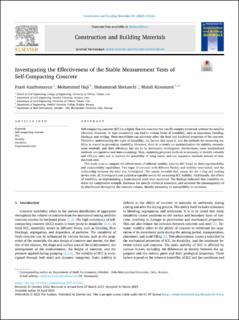| dc.description.abstract | Self-compacting concrete (SCC) is a highly flowable concrete that can fill complex formwork without the need for vibration. However, its high consistency can lead to various forms of instability, such as separation, bleeding, blockage, and settling. These instabilities can adversely affect the fresh and hardened properties of the concrete. Therefore, understanding the types of instability, the factors that cause it, and the methods for measuring stability is crucial in preventing instability. However, there is currently no standardization for stability measurement methods, and their efficiency has yet to be thoroughly investigated. Furthermore, some standardized methods are expensive and time-consuming. Thus, examining proposed methods is necessary to identify valuable and efficient ones and to explore the possibility of using easier and less expensive methods instead of standardized ones. This study aims to compare the effectiveness of different stability tests for SCC based on their reproducibility and measurability capabilities. Two types of concrete with different fluidity and stability were tested, and the relationship between the tests was investigated. The results revealed that, except for the J-ring and rocking device tests, all investigated tests yielded acceptable results for measuring SCC stability. Additionally, the effects of instability on implementing a beam-shaped mold were examined. The findings indicated that instability reduces the compressive strength, decreases the specific electrical resistance, and increases the inhomogeneity of its distribution throughout the concrete volume, thereby increasing its susceptibility to corrosion. | en_US |

